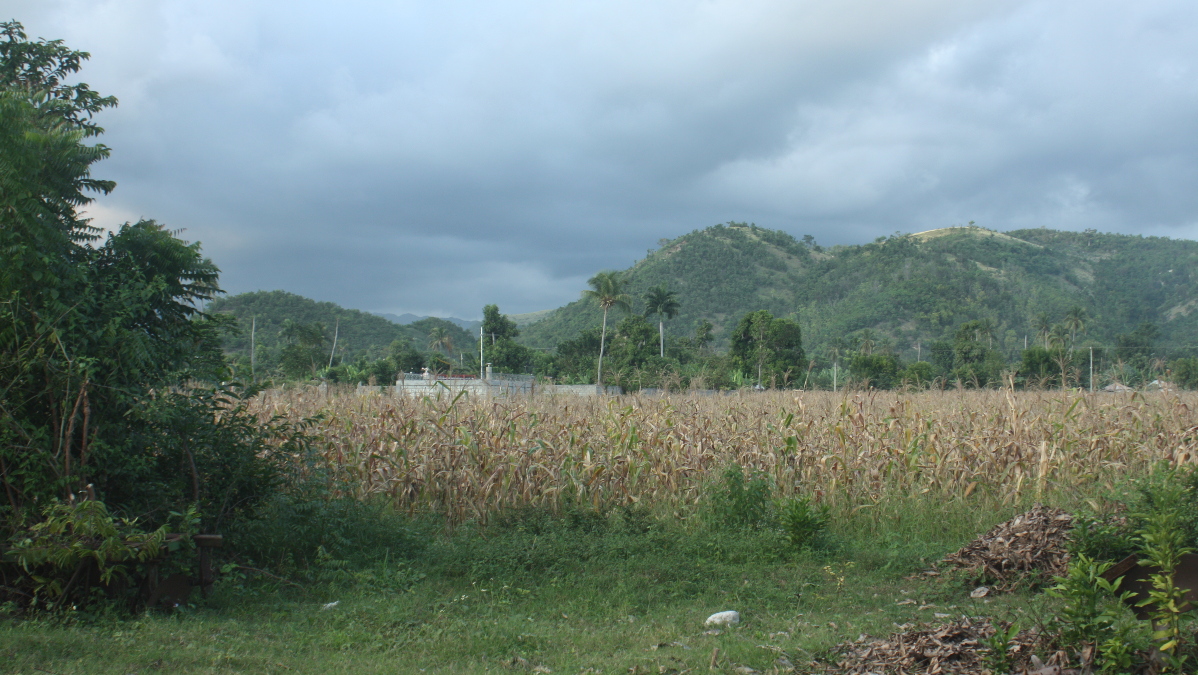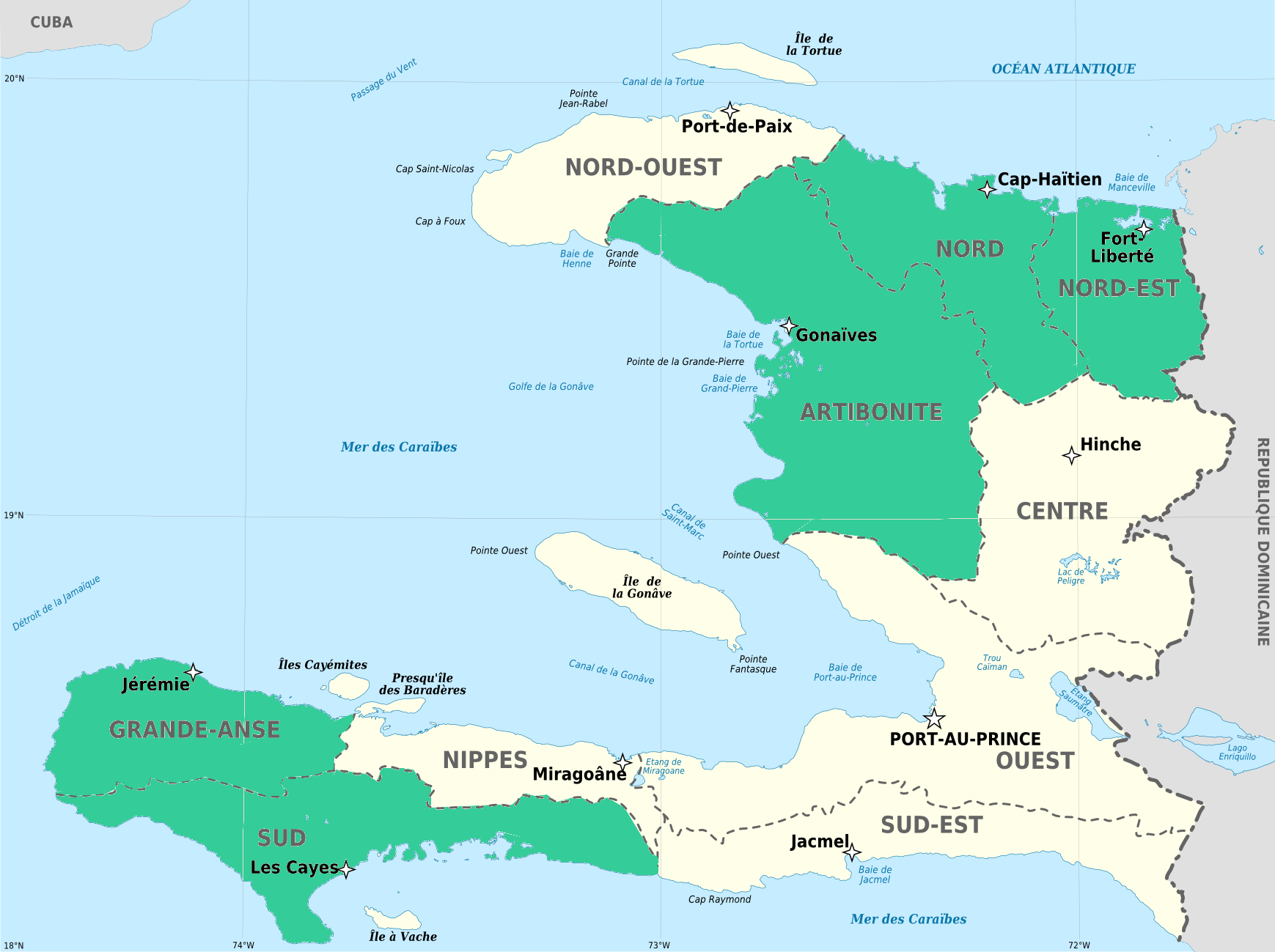Photo: Ami Vitale/Oxfam America
Haiti is a Small Island Developing State (SIDS) located in the Caribbean Sea. The country is still recovering from the devastating 2010 earthquake and Hurricane Matthew in 2016, and is highly vulnerable to external shocks and climate change.
Haiti is the poorest country in the Latin America and the Caribbean region and one of the poorest in the world, with 59% of its population living in poverty in 2014, according to the United Nations Development Program.
%
of Haitians live in poverty
The poverty rate is even higher in rural areas, which are affected by low agricultural productivity, high environmental degradation (deforestation and soil erosion) and poor nutrition. Results of a 2015 World Food Programme analysis indicate that approximately 47% of households are moderately or severely food insecure and one fifth of children below five years of age are chronically malnourished.
Agriculture plays a major role in the Haitian economy, contributing to 25% of the GDP and 85% of employment in rural areas. However, Haitian agriculture presents very low levels of productivity when compared to other countries in the region.
Agriculture in Haiti contributes
%
of the country's GDP
%
of employment in rural areas
To help small farmers improve their productivity and income levels, the Government of Haiti and the Inter-American Development Bank (IDB) have devised an investment program called Agricultural and Agroforestry Technological Innovation Program (in French Programme d’Innovation Technologique pour l’Agriculture et l’Agroforesterie, PITAG).
During 2017 and 2018, FONTAGRO provided technical support to help shape the program by identifying the main constraints that affect production in the major cropping systems of the country, and by establishing transparent procedures for funding development project proposals.
PITAG: Funding technological innovation to boost agricultural production and farmers’ income
The overall goal of the PITAG is to increase agricultural income and food security for smallholder farmers in selected targeted areas of Haiti. The development objectives are to increase agricultural productivity and improve the use of natural capital through the adoption of sustainable technologies.
The PITAG, to be implemented from 2018, has two main components:
- Applied research and training on sustainable agricultural technologies;
- Promotion of sustainable agricultural technologies and practices.
The first component of the project is financing research activities for developing sustainable agricultural technologies that are suitable for adoption by small farmers. The activities of this component should i) provide the building blocks for a strategic agriculture innovation program led by the Ministry of Agriculture, Natural Resources and Rural Development (MARNDR), and ii) strengthen its innovation team.
The second component will support the adoption of innovative, profitable and sustainable agricultural technologies that will improve the long-term profitability of farms and generate positive environmental outcomes.


The overall goal of the PITAG is to increase agricultural income and food security for smallholder farmers in selected targeted areas of Haiti.
Identifying constraints on productivity in Haiti’s cropping systems
FONTAGRO provided technical support to the MARNDR for the design and implementation of PITAG’s agriculture innovation program. In particular, it reviewed information on the lessons learned from previous experiences in research for development projects in Haiti and validated these findings with key local counterparts.
This allowed the identification of the main constraints that limited the yields in the major cropping systems in Haiti – namely: cocoa, coffee, legumes, maize and sorghum, vegetables, rice, and roots and tuber crops -, the definition of key issues to be addressed by the PITAG, and finally the detailing of the solutions proposed by previous research projects and programs for development.
Main constraints affecting the priority crops in Haiti, key issues to be addressed by the PITAG and possible research questions:
Coffee-based agroforestry
Main constraints:
- Old plantations
- Maintenance work limited, use of fertilizers rare
- Practices of gathering and drying beans leading to poor quality of the final product
- Varietal diversity reduced
- Many trees affected by root rot (favored by excessive shading of plantations), bark beetle (Hypothenemus hampei) and orange rust (Hemileia vastatrix)
- Important phenomenon of alternation of production (causes still unclear)
- Low revenues generated by coffee production. Need for improving coffee production and quality to derive income from the other components of the system
Key issues to be addressed by the PITAG:
- Increasing the productivity of the system through improvement of associations
- Rehabilitation of coffee plantations
- Effective fight against coffee pests
- Innovative modes of valorization of the other elements of the system: enhancement of fruits (mango, avocado, bitter orange, sweet oranges, bananas, breadfruit) and their products
- Targeting producers likely to enter a sustainable process of recovery of the coffee sector
Cocoa-based agroforestry
Main constraints:
- Gradual loss of interest by producers who substitute cocoa, dependent on export prices, by other crops that provide better food security
- Pre- and post-harvest losses significant (around one-third)
- Other components of the system (fruits, bananas and yams) under-valued
- Fruit trees affected by various diseases
Key issues to be addressed by the PITAG:
- Innovative solutions to improve the overall functioning of the system
- Replacement of cocoa and breadfruit trees destroyed by the Hurricane Matthew with varieties resistant to mealybugs and lethal yellowing, and early varieties of Jamaica, respectively
- Technical packages to limit the effects of black sigatoka in bananas (drainage, spacing)
Vegetables
Main constraints:
- Little diversity and varietal rotation
- Seedling preparation usually done in family nurseries at the farm level
- Population densities often too low
- Techniques to effectively control insects and diseases not mastered
Key issues to be addressed by the PITAG:
- Development and dissemination of technical itineraries to increase production per unit area (optimal combinations, strip cultures)
- Introduction of new varieties resistant to diseases and insects and of increased commercial value (e.g., introduction of off-season varieties)
- Opportunities for setting up crops in controlled environments (greenhouses, hydroponics, drip)
- Innovative warning, information and training system
- Training courses to farmers involved in seedling production
Legumes-cereals systems
(Rotation or association)
Main constraints:
- Corn (the most widely grown cereal crop) confronted with drought problems
- Sorghum (the second most important cereal) affected by aphids, stem borers and midge
- Bean yield limited by drought, strong winds, heavy rains at the end of the cycle (poor flowering, sprouting), and diseases such as mosaic
- Peanut mainly consumed in the form of peanut butter (manba), whose aflatoxin content is much higher than international standards
- Rapid degradation of soil fertility (long-fallow cropping systems mostly established on slash-and-burn systems and on the slopes, short fallow systems too intensively exploited)
Key issues to be addressed by the PITAG:
- Introduction, evaluation and dissemination of open-tolerant (OPV) maize varieties that are drought tolerant or low-nitrogen, disease-resistant, and with high nutritional value (QPM or bio-fortified)
- Introduction, evaluation and dissemination of aphids resistant sorghum varieties
- Introduction of drought tolerant and mosaic resistant bean varieties
- Reduction of the aflatoxin level of groundnuts and its derived products through the dissemination of technical packages and storage methods to reduce Aspergillus contamination
- Valorization of pigeon peas (canning, research of valorization of its medicinal virtues)
Sweet potato, cassava, yam and taro
Main constraints:
- Sweet potato development largely motivated by the loss of soil fertility
- Cassava mainly cultivated on marginal soils, and threatened in some areas by the multiplication of the crazy ant
- Yams development hampered by limited availability of quality seed and disease and pest problems in vegetation and storage
- Taros not really addressed by the research
Key issues to be addressed by the PITAG:
- Improvement of seed quality and reduction of degeneration (varieties more resistant to diseases that cause degeneration, technical routes limiting degeneration, and techniques for obtaining healthier seeds on the farm such as positive selection)
- Introduction and participatory selection of productive and high nutritional quality sweet potato and cassava varieties (sweet potatoes rich in vitamin A, cassava rich in beta-carotene and less bitter)
- Technical packages to reduce yield losses due to yam diseases and pests
Rice
Main constraints:
- High yield variation (interannual, between plots and between regions)
- Huge differences between yields in research stations and average yields in farmers’ fields
- Stagnation and sometimes decline in yield in places where yields have been high for many years
- Magnitude and determinants of these variations in yield still unclear, although the development of some diseases and parasites has been noted (black straw disease, bugs)
Key issues to be addressed by the PITAG:
- Yield variation analysis through agronomic diagnostic methods and analysis of the social, economic, biophysical and technical context
- Cultural practices favoring the sustainability of the system and the quality of harvested products
- Participatory selection of varieties with high yields, resistant to lodging, adapted to the harvesting system used by the farmers and corresponding to the habits of consumers
- Innovative warning and information system, using various means of communication
Another limiting factor that was identified was the huge diversity among research, development and extension agents – especially universities – in terms of expertise, capacities, facilities, critical mass of researchers and contact with development actors. This is an important element that was taken into consideration to inform the selection process of research and development sub-programs proposals (described below).
Designing the structure and procedures of the PITAG
FONTAGRO provided a series of recommendations for the design of the PITAG, especially regarding gender issues and climate change considerations, and defined six sub-programs, corresponding to the main cropping systems in Haiti, as well as target regions for each of them.
The six sub-programs and their target regions
Coffee-based agroforestry
 Grand’Anse, North
Grand’Anse, North
Cocoa-based agroforestry
 Grand’Anse, North
Grand’Anse, North
![]()
Market gardening (plain and mountain)
 A plain and a mountain region
A plain and a mountain region
(optional department in the area of intervention)
Legumes-cereals systems
 Artibonite, South
Artibonite, South
Sweet potato, cassava, yam and taro
 Artibonite (sweet potato), North (cassava, yam), North-East (cassava), Grand’Anse (yam), South (taro)
Artibonite (sweet potato), North (cassava, yam), North-East (cassava), Grand’Anse (yam), South (taro)
Rice
 Artibonite, South
Artibonite, South
In addition to the six-subprograms, four ‘special projects’ were also designed as a way to swiftly address the most urgent problems affecting the Haitian agriculture:
- Development of small agricultural mechanization
- Identification and integrated management of agricultural diseases and pests
- Post-harvest storage of agricultural commodities;
- Development of sustainable methods for improving soil fertility under low-input and polyculture conditions.
These thematic and ‘horizontal’ projects that concern most of the cropping systems will also have an important role in the development of coordination among sub-programs.
FONTAGRO also assisted with the drafting of all the documents and procedures to be followed during the implementation of the program, including:
- A call for expressions of interest, inviting research entities interested in participating in the six sub-programs and four special projects to form a consortium (that will later submit proposals) comprised at the minimum of one national university, one national development actor working in the target regions and one foreign organization;
- A request for proposals, inviting the eligible consortia to submit proposals, including a brief diagnosis of the concerned sub-program, state of art of the research, description of training activities and actions that will be taken to reinforce the capacity of the teams, and expected key products;
- The terms of reference of operators, support staff, and members of the execution unit;
- A communication strategy for the PITAG;
- A general policy paper on the awarding of scholarships for master’s degrees in foreign universities.
The implementation of the PITAG is currently under way. The subprogram 6 (rice systems) was launched in May 2019. The other subprograms should start around mid-June 2019. Expressions of interest have been received for the four special projects, and the requests for proposals should be sent in June 2019.
For more information, please contact:
Carmine Paolo De Salvo desalvo@IADB.ORG
Eugenia Saini esaini@iadb.org



